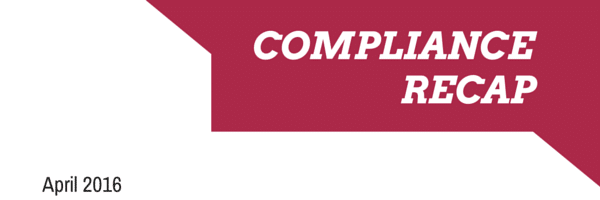Catch up on compliance developments you may have missed last month with UBA’s April 2016 Compliance Recap.
As much of the country anxiously awaits the Department of Labor’s (DOL) long-promised final rule relating to overtime exemption regulations, the employee benefits space has been relatively quiet. March 31 was the first deadline relating to the IRS reporting of the employer shared responsibility provisions under the Patient Protection and Affordable Care Act (ACA) and a quiet April was likely a welcome relief. The DOL issued its 31st FAQ relating to ACA implementation. The IRS also issued the 2017 limits for health savings account (HSA) contributions and high deductible health plans (HDHPs).
UBA Updates
UBA released two new guides to assist employers:
Same-Sex Marriage and Group Benefits
DOL FAQ
The DOL has issued its 31st FAQ on the implementation of the ACA dedicated to coverage of preventive services, rescissions of coverage, out-of-network emergency services, clinical trial coverage, cost-sharing limitations, the Mental Health Parity Act, and the Women’s Health and Cancer Rights Act. Non-grandfathered group health plans must ensure that annual cost sharing does not exceed certain limitations that are set annually. The FAQ indicated that, for non-grandfathered large group or self-insured group health plans with pricing structures in which a participant pays a “reference price” for a procedure, but that do not have enough quality providers that accept the reference price as payment in full, out-of-pocket expenses for those individuals must count toward the individual’s maximum out-of-pocket limit.
IRS Sets Limits
The IRS has announced that, for calendar year 2017, the annual limitation on contributions for individual self-only coverage with an HDHP is $3,400. The annual limit on contributions for an individual with family coverage under an HDHP is remaining at $6,750.
In comparison, the 2016 annual limitation on contributions for individual self-only coverage with an HDHP is $3,350.
For 2017, a health plan with an annual deductible cannot be less than $1,300 for self-only coverage, or $2,600 for family coverage and the annual out-of-pocket expenses cannot exceed $6,550 for self-only coverage or $13,100 for family coverage. These are the same limits as 2016.
Question of the Month
Q. Under the W-2 safe harbor, coverage is affordable if the employee’s contribution for self-only coverage is less than 9.5 percent (indexed to 9.56 percent in 2015, and 9.66 percent in 2016) of his W-2 (Box 1) income for the current year. What does Box 1 income include?
A. Box 1 income is an individual’s total taxable income for the year. It excludes deferrals to 401(k), 403(b) and Section 125 plans. It will also be lowered in the event an employee takes an unpaid leave of absence. The safe harbor does not adjust for any of these deferrals or leaves of absence, which can increase the chance that an employer’s offer of coverage will be unaffordable.












